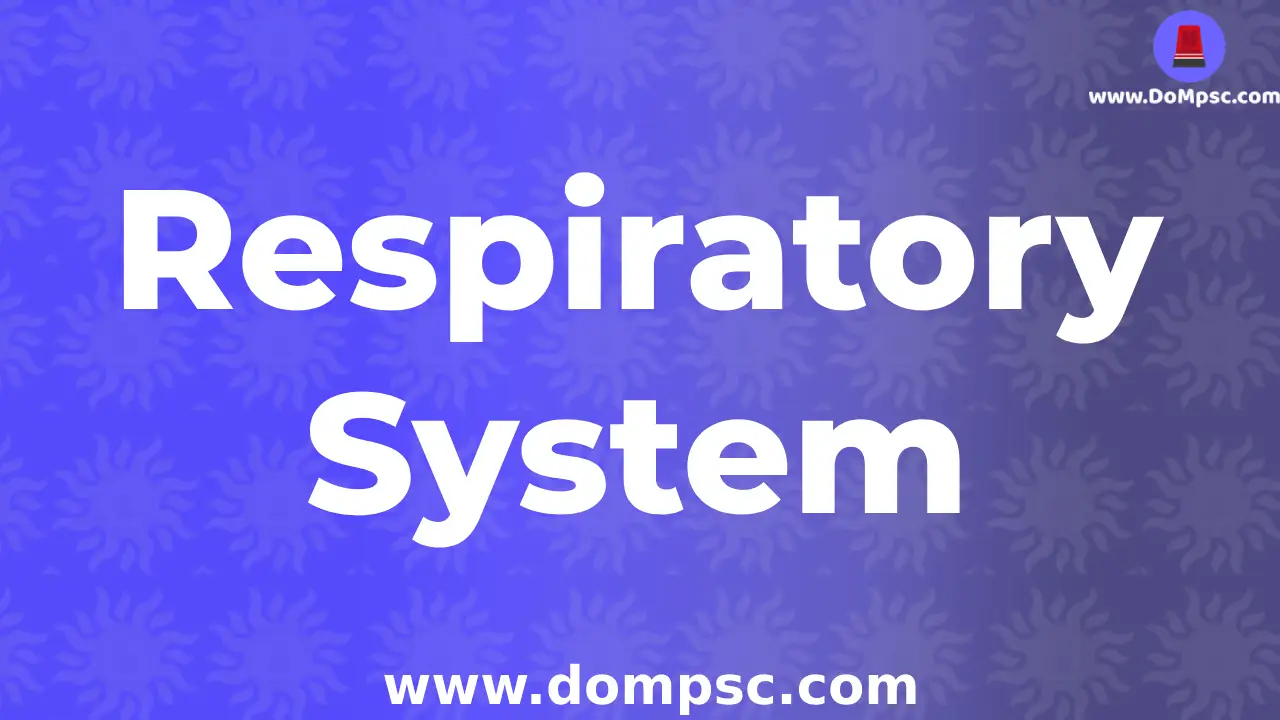MPSC Respiratory system (श्वसन संस्था)-MPSC Biology science notes

✪Download pdf Works Properly on chrome Browser✪
Respiratory system (श्वसन संस्था)
Table Of Contain-Mpsc respiratory system (श्वसन संस्था)
Introduction of Respiratory Systems

By Shubham Vyawahare
0-May-2025
➤ Just a process of Inhalation and and exhalation is not a whole respiratory systems, it also include a process of releasing food from digested food.
➤ It also transfer a energy to a tissue and cells in human body.
✪ There are two types of Respiratory System in the Human Body ✪
Aerobic Respiration:
Energy releases with the help of oxygen is called as aerobic respiration.his type of respiration is common in most of the plants and animals, birds, humans, and other mammals. In this process, water and carbon dioxide are produced as end products.
Eg.Human Respiration,Bird respiration ,plants respiration
➤Final reaction Of a aerobic process is: C6H12O6 + 6O2 yields 6CO2 + 6H2O + energy (as ATP).
➤In this reaction Glucose (C6H12O6 ) is oxidized to produce carbon dioxide (CO2) and oxygen (O2) is reduced to produce water (H2O).
➤type of ATP production is seen in anaerobe and facultative anaerobes.
➤ Aerobic respiration has four stages: glycolysis, a transition reaction that forms acetyl coenzyme A, the citric acid (Krebs) cycle, and an electron transport chain and chemiosmosisAnaerobic Respiration:
Energy releases without presence of oxygen is called as anaerobic respiration. the energy is obtained by the breakdown of glucose in the absence of oxygen
eg.fermentation in yeast.
➤ Molecular oxygen is the most efficient electron acceptor for respiration, due to its high presence for electrons.Some organisms have evolved to use other final electron acceptors, can perform respiration without oxygen.
➤ Many bacteria and archaea can only perform anaerobic respiration.
➤ Stages Involved In Anaerobic Respiration is:
1.The first stage of the aerobic and an-aerobic respiration is glycolysis. In the glycolysis, the glucose molecule breaks down into two three carbon compound pyruvic acid.
2.The pyruvic acid made in first stage undergoes incomplete oxidation i.e., fermentation. The incomplete oxidation of the pyruvic acid produce ethanol or lactic acid.
3.The Third stage is electron transport system completed on the inner mitochondrial membrane. Water is formed by utilization of oxygen and hydrogen is supplied from the NADPH, FADPH.
Steps of Respiration system
Breathing:
This is the process of inhaling a air into a body.➤ This inhaled air transfer to the lugs via Bronchi and alveolus.
➤ In the outward process the air filled with carbondiaoxide is exhale by the body.
➤ At the end the inhaled air contact with air and transfer to it.
Cellular Respiration:
➤ The air contacted with the blood in the breathing process now proceeds forward.➤ That air transfer to each cells by red cells present in the blood.
✪ Important Stages involve in Human Respiration Systems ✪
- Nostrils (नाकपुड्या)
- Pharynx (घसा)
- Larynx (कंठ)
- Trachea (श्वसननलिका )
- Bronchi (श्वसनी)
- Bronchiole (श्वसनिका)
- Alveolus (वायुकोष)
1. Nostrils (नाकपुड्या)
➤This is first stage of respiration system.➤ This is the just a human nose and its hollow space.
➤ This involves a small hairs which avoid and protect from entering harmful content in the body.
➤ Bowman Gland presence in the human nose secretes a MUCUS which generate a sticky content in the nose.
➤ septum is the cartilage in the nose that separates the nostrils.
➤ primary purpose of the external nares is to let air enter the nasal cavities so it can be purified and sent to the next parts of the respiratory tract. It also allows different scents to enter the nose and reach the olfactory region of the nose.
➤ the Most important work of the nostrils is inhalation of air and exhalation of air.
2. Pharynx (घसा)➤This process take place in both inhalation and the food taking.
➤ The eustachian tube is a canal that connects the middle ear to the nasopharynx, which consists of the upper throat and the back of the nasal cavity
➤ Choane is the middle point of pharynx and the nostrils.
➤ Glottis is the middle point of pharynx and larynx.
➤ The anterior portion is the nasal pharynx, the back section of the nasal cavity. The nasal pharynx connects to the second region
➤ the oral pharynx, by means of a passage called an isthmus
3. Larynx (कंठ)➤The air coming from the pharynx is transmitted toward a Trachea (श्वसननलिका ) by a Larynx.
➤ It includes a Epioglottis which covers a foodtube ans inhalation tube so that the food never goes to inhalation tube .
➤ It also know as a sound box.Because it produces a sound. ➤ It has vocal chord which produces sound.male body has a 20mm vocal chord and female has 5mm vocal chord.
➤The larynx is composed of 3 large, unpaired cartilages (cricoid, thyroid, epiglottis);
4. Trachea (श्वसननलिका )
:➤The main work of Tranchea is flow the air from its input to the output part.➤ Commonly called the windpipe
➤ Flow main airway to the lung.
➤ It separate into the right and left bronchi, channeling air to the right or left lung.
➤ hyaline cartilage is the all of trachea which support as a back bone for trachea
➤The trachea consists of four histological layers. The mucosa represents the innermost layer and it is lined with pseudostratified ciliated columnar epithelium. The second histological layer is the submucosa.
➤ mucus in the trachea helps capture microorganisms such as viruses and harmful bacteria before they enter the lungs.
5. Bronchi (श्वसनी)
➤There are two Btonchi in the human body.right bronchi and left bronchi➤ Right bronchi is little bit wider than the left bronchi.
➤ The things which are taken in by human accidentally is stuck in the right bronchi.
➤ The bronchi are made up of cartilage, smooth muscle, and mucous membranes
➤ thoracic verterbra is junction between the trachea and the bronchi.
➤ The bronchi become smaller the closer they get to the lung tissue and are then considered bronchioles.
Lungs (फुप्फूसे)
The Lungs Contain Bronchiole and Alveolus6.Bronchiole (श्वसनिका)
➤When Bronchi Enters into the lungs is get converted in to the small two parts, So the smallest part is called as a Bronchiole.➤ Bronchioles carry oxygen rich air into the lungs and carry carbon dioxide rich air out of the lungs.
➤ Thereby aiding in the processes of breathing and respiration
➤ There are three types:Lobular bronchioles,Terminal bronchioles,Respiratory bronchioles
➤ The lobular and terminal bronchioles are referred to as "dead space" because no air exchange occurs in these passages.
➤ around 300 million alveoli present in the lungs.
7. Alveolus (वायुकोष)
➤Alveolus is the working and executive part of the lung.➤ It produce air balloons when man inhale the air from nose.
➤ The Maximum part of the lungs consist of Alveolus
➤ Alveoli are the center of your respiratory system’s gas exchange
➤ lungs take in about 1.3 to 2.1 gallons (5 to 8 liters) of air per minute.
➤ Alveolus (singular of alveoli) is about 0.2 millimeters in diameter (about 0.008 inches).
➤ Alveoli cells cover 95 percent of the alveolar surface and constitute the air-blood barrie.
➤ There are near about 300 million alveoli present in the lungs.
✪ Terms Related with the Respiratory Systems ✪
✪ Eupnea- Perfect Respiration (12-18/Per minute)
✪ Hypopnea- Low Respiration rate
✪ Hyperpnea- High Respiration Rate
✪ Dysapna- Panic Respiration
✪ Hypoxia- Oxygen deficiency in a cells
Respiratory Disease
✪ Asbestosis:a lung disease resulting from the inhalation of asbestos particles
✪ Silicosis:Happens in jobs where you breathe in dust that contains silica
✪ Byssinosis:Due to inhalation of cotton particles.
✪ Anthracosis:Due to inhalation of coal particle.
Others Blogs Related to MPSC Biology Notes
➤Biology Exam Pattern
➤Blood Circulation System
➤Blood Groups And Its Diseases
➤Balanced Diet And Nutrients
➤Classification Of Animals
➤Classification OF Plants
➤Cell
➤Tissue
➤Coordination In Human
➤Digestive System
➤Diseases And Disease Types
➤Excretory System
➤Respiratory System
➤Reproductive System
➤Skeletal System
Read All MPSC blogs
- ➤केंद्र सरकारने खाजगी क्लासेस साठी नवी नियमावली लागू केली आहे |GUIDELINES FOR REGULATION OF COACHING CENTER in marathi
- ➤MPSC Data leak: पेपर न फुटल्याचा दावा MPSC आयोगाने स्पष्टपणे केला आहे
- ➤MPSC hall ticket data leaked before 6 days of exam
- ➤MPSC Data leak: टेलेग्राम वर अचानक ९० हजार परीक्षार्थींचे प्रवेशपत्र झाले लिक
- ➤मराठी भाषेला अभिजात दर्जा मिळायला हवाच , अभिजात दर्जा नेमका कसा मिळतो ?
MPSC Books pdf



